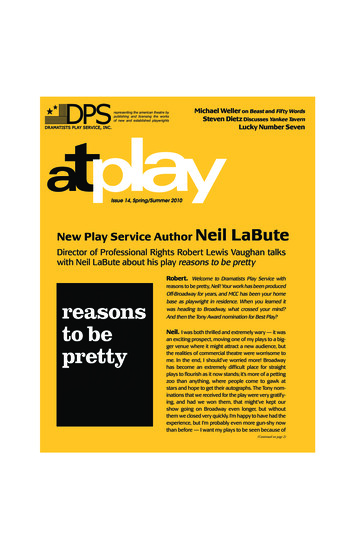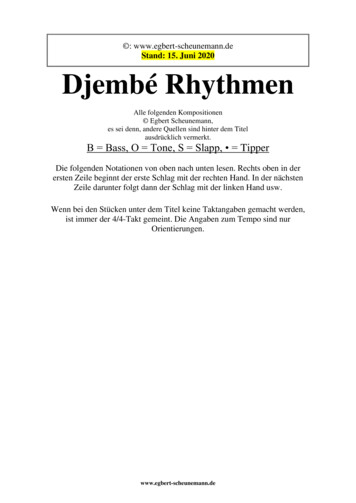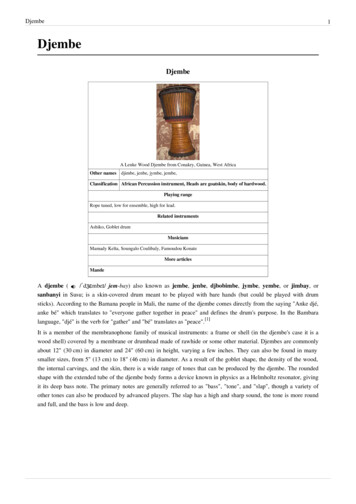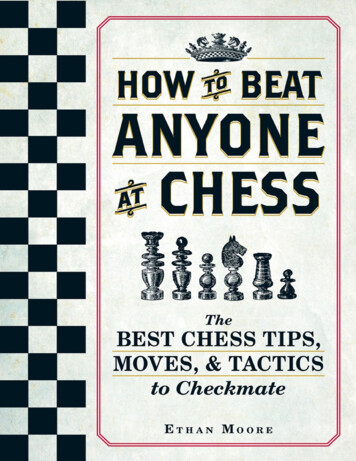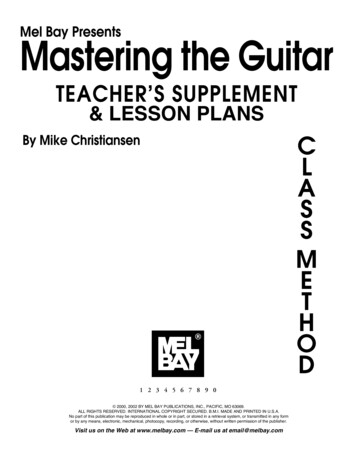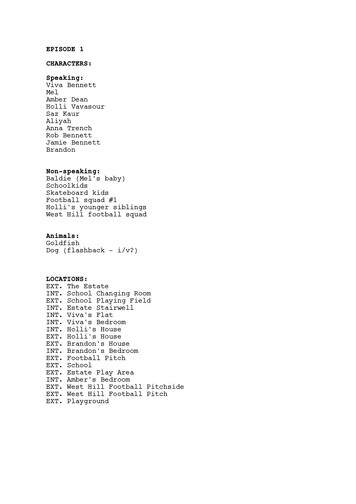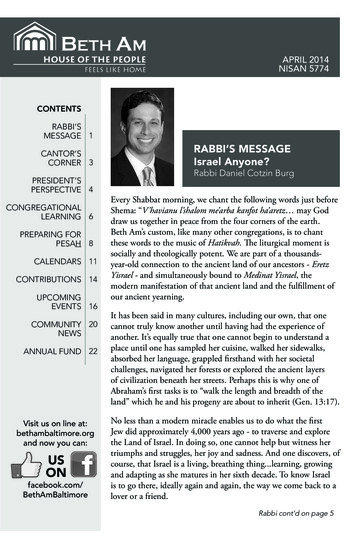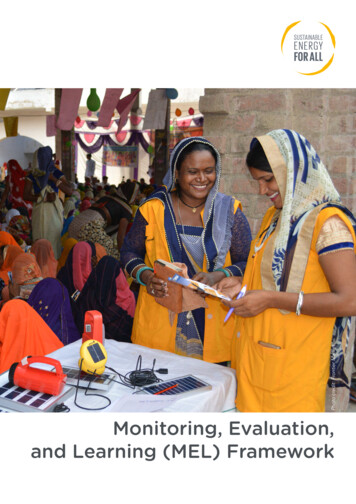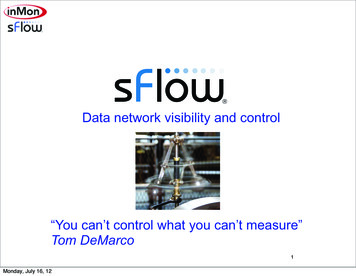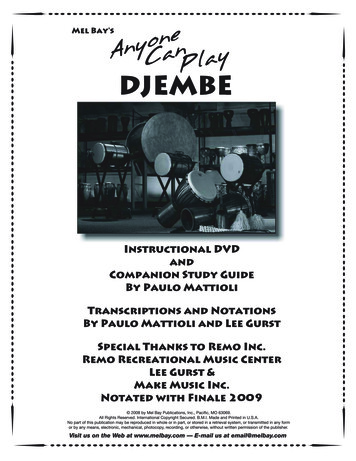
Transcription
1Anyone Can Play DjembeBy Paulo MattioliIntroductionAnyone Can Play Djembe is a valuable tool to help the novice player learn theessential fundamentals of playing the Djembe musically, and to facilitate joyful,creative expression. Learning is facilitated through in-depth, interactiveaudio/video instruction, play-along learning and written parts in both phonetic andstandard music notation. Anyone Can Play Djembe is unique in that it offersinstruction not only in traditional Djembe rhythms, but also original rhythms andtheir applications in contemporary music. The program includes learning: Hand positions and strokes: The fundamentals Bass, Tone and Slap. Drum communication: Use of drum breaks/signals to set tempos and toindicate the starting and ending of rhythms. Traditional Djembe rhythms: Their parts and polyrhythmic relationships. Historical and cultural background: On the Djembe and the traditionalrhythms presented. Original Djembe rhythms: Applicable to contemporary world music. Resources: Further Djembe instruction and Djembe music.Getting StartedThe multi-media format of Anyone Can Play Djembe is designed to facilitateyour learning process regardless of previous training. It includes a combination ofsupportive text, standard notation scores, phonetic notation scores and aninteractive audio/video training on CD & DVD. Whether you learn best fromauditory, visual or written material, you will have all the tools you need. Theprogram was created using audiophile quality recording (24 bit, 48 khz soundrecording) and was shot in High Definition Anamorphic Widescreen video. It wasthen optimized for the best possible quality audio/video output on standard DVDplayers, widescreen TV’s and stereo audio systems, (anamorphic widescreen SDvideo with 44.1 khz audiophile quality CD sound).You don’t have to know how to read music to use this program! You canlearn using the phonetic notation scores provided along with the DVD & CD.There’s nothing to it, but to do it! So let’s get started Insert the DVD into your DVD player. It will load and play the introductionautomatically and take then you to the “Main Menu.”
2Using the DVD & Booklet: Lesson PlanDVD NAVIGATION: Using your DVD’s remote control arrow keys,navigate to your menu choice and hit the ENTER key (or select key). Forcomputer viewing, click on the colored box next to your menu choice toselect the menu item. For best results, I suggest you move through thelesson program in the following order.MAIN MENU:1. BASS/TONE/SLAP2. BREAKS3. RHYTHMSUsing the booklet, scores and DVD together will help you learn more easily. Takeyour time and do not try to learn everything contained in the program in onesetting, as there is a lot of material and trying to cover it all at once may becounterproductive. Warm up practicing the strokes, then pick one rhythm andlearn all the parts. Practice your solo improvisation for that rhythm. Advance tothe next rhythm on another study session.Daily practice will surely speed you along the drumming path. I suggest youpractice for at least 45 minutes a day. Make it focused time, your sacred “DrumTime.” Whenever you able, carve out a longer chunk of time to study. Gettogether with friends who also drum and enjoy playing the rhythm parts together.Studying with a personal teacher is also important, so that you get personalizedfeedback and guidance on your drumming.Use the DVD and the written materials together. The written materials alone arejust a road map, graphically symbolizing the rhythms. Hearing, seeing andplaying along with the “Ensemble” on the DVD will truly enhance your learning ofthe rhythms and their relationships to each other. By playing along with the DVDor CD you will also learn to hold your part steadily while the other supportingparts and solo rhythms are playing. The DVD and CD provide you a way topractice playing with the other parts, similar to a live situation.Below I have provided an in depth lesson plan for you to follow as youwork through the program material.Have FUN with the process!1. BASS/TONE/SLAP: A good foundation for hand drumming begins withlearning the strokes and tones. Simply choose “BASS-TONE-SLAP”from the DVD’s “MAIN MENU”. If you already know the strokes andtones proceed to warm up your hands with a continuous rhythm pattern.Combinine all three tones: “Bass, Tone and Slap” as follows; four opentones, four slap tones, four bass tones in succession, performedcontinuously with alternating hands. Gradually increase your tempo
3while maintaining the integrity of each tone. Continue to refine yourtones, technique, stamina and dexterity.2. BREAKS: Learn the drum communication signals by choosing“BREAKS” from the “MAIN MENU”. Refer to the rhythm scores andnotation to get a visual on the rhythm patterns.3. RHYTHMS/ENSEMBLE: Watch and listen to the overall rhythmfirst.I suggest you begin by learning all the traditional rhythms, then move tothe original rhythms for the song “Straight Ahead” when complete.Select “Rhythms” from the main menu to bring up a choice of rhythms.Then choose “Ensemble” on the rhythm page. It will be helpful for youto simply listen to the “Ensemble” at least once before playing along toget a feel for the overall rhythm. Refer to the rhythm scores andnotation to get a visual on the rhythm patterns.4. Sangban, Kenkeni and Dununba parts: These parts are best learnedfirst and in this order. They are foundational to the rhythm itself andserve as a reference point within the rhythm. Select these parts fromthe “Play along and learn” section at the top of the rhythm menu page. Isuggest you then refer to the notation to get a visual on the rhythmpatterns.5. Djembe Instruction: Select “DJ-1” for in depth instruction on Djembe#1. Again, use the rhythm scores/notation to get a visual on the rhythmpatterns. Once you have learned the part, select “1st DJEMBE” fromthe “Play along and Learn” section at the top of the Rhythm menu, topractice the part in conjunction with all the other supporting instruments.6. Select “DJ-2” for instruction on the second Djembe part and once youhave learned it, choose “2nd DJEMBE” at the top of the menu page.Now practice the 2nd Djembe part along with the other instruments. Asyou get comfortable playing your part pay attention to the relationship ofyour part to the other supporting parts.7. “ENSEMBLE”: Select “ENSEMBLE” and choose a supporting rhythmpart to perform with the entire ensemble. Focus on maintaining thegroove and consistency with your part. At first you may need to focuson your part only and tune out the solos in order to hold your partsteady. When you are solid on your part, listen to the Djembe solos asyou play. Let them be an inspiration and starting point for you to beginto create your own original improvised solos.8. SOLO’S: Select “ENSEMBLE” to play along with the solos. Select“SANGBAN” to practice original soloing with the ensemble. Bychoosing “Sangban” from the top of the Rhythm menu you will hear allEnsemble supporting parts without solos during playback. Thus leaving
4space for you to solo throughout. Doing so will also highlight the“Sangban” part, an essential reference point for the solo Djembe. Nowimprovise, playing your solo with the group as you listen to the Sangbanfor reference with respect to the rhythmic cycles/phrases. Begin andend your solos with a signal that coincides with the beginning and endof the ensemble rhythms phrase (EG: Eight bar increments).9. ORIGINAL DJEMBE RHYTHMS: Select “STRAIGHT AHEAD” fromthe Rhythms Menu, watch and listen at least once to the “ENSEMBLE”section of the DVD to get a feel for the overall piece.10. DJEMBE INSTRUCTION: Learn Djembe #1 first, by selecting “DJ-1”from the bottom of the rhythm menu page. For further support refer tothe rhythm score/notation to get a visual on the groove rhythm patternsand variations of the groove.11. “STRAIGHT AHEAD”/ ENSEMBLE: Select Ensemble to practiceplaying along on either Djembe part. Refer to the Straight Aheadensemble notation to get a visual on the rhythmic variations, whichoccur at the phrase endings, (called “Turnarounds”). Enjoy improvisingyour parts, turnarounds and solos by playing along with the “Ensemble”selection. Try your hand at creating solos of your own that buildrhythmically and dynamically with the natural rhythm phrasing of thesong.About the Djembe:Cultural OriginsThe Djembe originated in West Africa, specifically from the great Mali empirefounded by the Malinke ethnic group of the Manding (or Mande) people. Whilethe exact year of origin is difficult to pinpoint, we know that it dates back at leastto the 15th century and possibly as far back as 1200 AD (when the Mali Empirewas established). The Mali Empire encompassed the present day countries ofMali, Guinea, Burkina Faso, Ivory Coast, Sierra Leone, Liberia, Gambia andSenegal.The Bamana people in Mali say that the name of the Djembe comes directly fromthe saying "Anke dje, anke be," which literally translates to "Everyone gathertogether." "Dje" is the verb for "gather" in Bamanakan and "be" translates as"everyone." This certainly describes the drums purpose and function.According to Kemoko Sano, one of the greatest authorities of this tradition, theDjembe was likely born out of the mortar and pestle used by the women of thevillages to pulverize grain. The mortar is a conical wooden bowl that tapers frommouth to base and is closed at the bottom. The pestle is a tapered rod withrounded ends used to crush the grain in the bottom of the bowl. These tools werecarved from sections of tree trunks by the village blacksmiths. Mamady says thatmany of the rhythms now played on the Djembe originated from the women of
5the village. Rhythms were used to celebrate significant events in the life of thevillagers. For example the women would gather round a mother who had recentlygiven birth and they would celebrate by creating rhythms comprised of threedistinct tones of hand clapping, as they sang together in rich harmonies.The men of the village wanted to support and contribute to the celebration. Bystretching a skin (originally antelope was used) over the top of the mortar, theDjembe was born. An ancient ceremonial West African drum called the“Boogarouboo” found in the Casamance region of southern Senegal and inGambia retains the shape of the mortar, except opened in the bottom and is stillplayed to this day to the accompaniment of clapping and singing.Over the generations, the shape and craftsmanship of the Djembe evolved underthe skilled hands of the blacksmiths who had the tools and expertise to shape it.The bottom was opened up and the bowl was enlarged and lengthened forresonance to become what Kemoko Sano called “The Magic Drum.” Magic, hesaid, because nobody could resist dancing when they heard its song.Today the Djembe in Africa incorporate modern features. The leather stitchinghas evolved into using steel counter hoops to cinch the skin. Leather cord is nowreplaced by nylon climbing cord or sailing cord, prized for its ability to hold hightension.The Djembe plays an integral role in the music, ceremonies and traditions of theManding. Every traditional rhythm has a purpose and cultural context in which itplays a key role. Every significant event in life; birth, coming of age, planting ofcrops, marriage and prayer are marked by ritual ceremonies which includespecific rhythms, music, dance and song. The traditional rhythms and ritualceremonies weave together to create the very fabric of life. Music is key inproviding communication, connections to the family, village, ancestors and thespiritual realm. Rhythm for the Manding is integral to life itself.The Djembe is usually accompanied by the other instruments in its immediatefamily. Collectively know as DUNUNS, individually they are the SANGBAN,KENKENI and DUNUNBA. The Dununs each have their own bell rhythms, thesecylindrical, double-headed drums provide the middle, high and low sounds for thebass section of the ensemble and form the rhythmic and melodic foundation forthe ensembles songs.The Manding instrument family also includes the ancestors of a great number ofmodern instruments in use today. The baliphone (marimba / keyboard), kora(harp / guitar), bolon (bass), flutes, rattles, bells, talking drums and the dji dunun(water drums) are only a small part of the vast array of instruments that come tous from this rich musical heritage.For generation after generation the Djembe has been bringing people together inharmony. From its origins in the villages of West Africa it has transcended allboundaries of geography, language, culture, age and gender. The Djembe
6rhythms, dances and songs have grown tremendously in popularity andinfluence. I believe that they will continue to do so for many generations to come.As the Djembe and its music connect people across the globe in the shared joy,healing, and heartfelt connection that arise from drumming together in harmony,it is vital that we know and honor their origins in the rich Manding culture. It isimportant as well to distinguish between traditional rhythms, and the neweroriginal rhythms and drumming modalities, while honoring all.The Djembe in Conte mporary MusicAs we have discussed, the Djembe is a living instrument that continues to evolvein its construction and applications. Contemporary Djembe construction isincorporating new materials and technologies that enhance it. The SignatureSeries generously donated by Remo for use in this program incorporate greatsounding Nuskin heads. These drum heads stay in tune regardless of humiditychanges. They have strong, lightweight and very resonant drum bodies made ofadvanced Acousticon (a hybrid of hardwood and fiberglass) that are extremelyresistant to cracking or warping. They have a beautiful scratch resistant handapplied Bronze Metalized finish, which adds to their strength and soundquality. All in all these innovations make for an extremely user friendly, durableand f
Original Djembe rhythms: Applicable to contemporary world music. Resources: Further Djembe instruction and Djembe music. Getting Started The multi-media format of Anyone Can Play Djembe is designed to facilitate your learning process regardless of previous training. It includes a combination of supportive text, standard notation scores, phonetic notation scores and an interactive audio/video .
